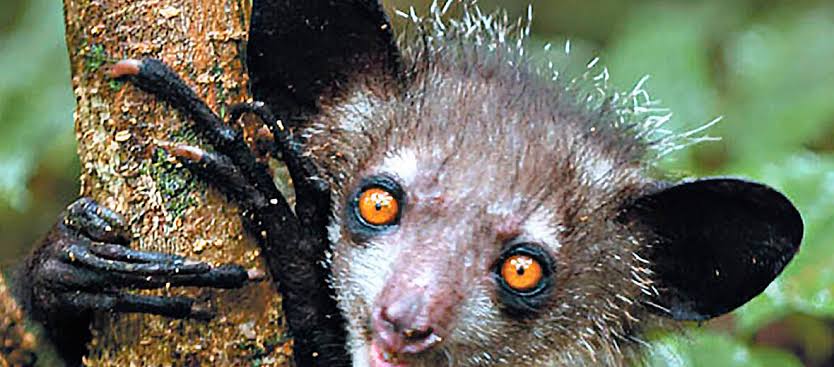Aye-ayes, fascinating creatures native to Madagascar, have unique hunting and protective behaviors that set them apart in the animal kingdom. These nocturnal lemurs primarily forage for food at night, using their specialized long middle fingers to tap on tree bark. This tapping sound helps them locate tunnels made by wood-boring insect larvae hiding inside. Once located, the aye-aye gnaws into the bark using its sharp incisors, extracts the larvae with its elongated middle finger, and consumes them. This hunting technique, known as percussive foraging, showcases the aye-aye’s adaptation to its environment and specialized feeding habits.

Adaptations for Nocturnal Foraging
Aye-ayes are well-adapted for nocturnal hunting, relying on their keen senses of hearing and touch to locate prey in the dark. Their large, sensitive ears enable them to detect faint sounds produced by insects moving within tree bark. The aye-aye’s specialized middle finger, equipped with a ball-and-socket joint, acts as a versatile tool for probing and extracting insect larvae from narrow crevices. This adaptation allows them to efficiently exploit a niche food source that other animals may find inaccessible or challenging to obtain. By foraging primarily at night, aye-ayes minimize competition with diurnal species and maximize their chances of finding food in their forest habitat.
Social Structure and Communication
Aye-ayes are solitary animals, except during brief periods of mating or when females are caring for young. They establish and defend territories within their forest habitat, marking boundaries with scent glands located on their throats and chests. While solitary, aye-ayes communicate through various vocalizations, including clicks, squeaks, and grunts, which may serve to deter potential threats or attract mates during the breeding season. Their solitary nature and territorial behavior help protect them from competition for resources and potential predators within their forested environment.
Predation and Defensive Strategies
Despite their nocturnal habits and solitary lifestyles, aye-ayes face threats from natural predators such as fossas, Madagascar’s largest carnivores, and birds of prey like the Madagascar harrier-hawk. To avoid predation, aye-ayes rely on their excellent climbing abilities and agility in the trees. They move swiftly through the dense canopy using their strong limbs and grasping hands, which allow them to escape to higher branches or retreat into tree hollows inaccessible to larger predators. Aye-ayes also exhibit cryptic coloration, blending with their forest surroundings to avoid detection by predators during daylight hours when they rest in secluded nests or tree cavities.
Reproduction and Parental Care
Aye-ayes have a slow reproductive rate compared to other lemurs, with females typically giving birth to a single offspring every two to three years. Gestation lasts for approximately five months, after which the female gives birth to a helpless infant that clings to her belly. The mother provides extensive care and protection for her offspring, nursing them for several months until they are old enough to begin exploring their surroundings and learning essential survival skills. Parental care plays a crucial role in the survival of young aye-ayes, ensuring they develop the physical and behavioral adaptations needed to thrive in their forest habitat.
Conservation Challenges and Efforts
Aye-ayes face significant conservation challenges due to habitat loss, fragmentation, and hunting pressure in Madagascar. Deforestation for agriculture, logging, and human settlement has reduced the availability of suitable forest habitat for aye-ayes and other wildlife. Fragmentation of forested areas further isolates aye-aye populations, limiting their ability to find mates and access essential resources. Additionally, aye-ayes have been historically persecuted by local communities who view them as symbols of bad luck or spiritual omens, leading to targeted hunting and persecution. Conservation efforts focus on protecting remaining forest habitats, raising awareness about the importance of aye-ayes in local ecosystems, and implementing measures to mitigate human-wildlife conflict.
Vote
Who is your all-time favorite president?
Research and Conservation Initiatives
Scientific research plays a crucial role in understanding the behavior, ecology, and conservation needs of aye-ayes. Researchers study aye-aye populations in their natural habitats, using techniques such as radio telemetry, camera traps, and genetic analysis to monitor population trends, movement patterns, and genetic diversity. Conservation organizations collaborate with local communities, government agencies, and international partners to develop sustainable land-use practices, promote reforestation efforts, and establish protected areas where aye-ayes and other endemic species can thrive. Educational programs and ecotourism initiatives also contribute to local economies while fostering appreciation for Madagascar’s unique biodiversity and cultural heritage.
Cultural Significance and Conservation Ethics
Aye-ayes hold cultural significance in Malagasy folklore and traditions, where they are sometimes revered as ancestral spirits or guardians of the forest. However, negative superstitions and misconceptions surrounding aye-ayes have contributed to their persecution and illegal hunting in some regions. Conservation ethics emphasize the importance of respecting local beliefs and traditions while promoting sustainable coexistence between humans and wildlife. Engaging with local communities through dialogue, education, and collaborative conservation efforts helps foster mutual understanding and support for protecting aye-ayes and their habitats.
The conservation of aye-ayes and their unique habitat faces ongoing challenges and opportunities. Climate change poses additional threats to Madagascar’s biodiversity, affecting forest ecosystems and altering the distribution of species. Adaptive management strategies, informed by scientific research and community engagement, will be essential in addressing these challenges and ensuring the long-term survival of aye-ayes in their natural environment. By prioritizing habitat conservation, sustainable development, and cultural sensitivity, stakeholders can work together to safeguard Madagascar’s biodiversity and promote harmony between people and wildlife.
Summary
Aye-ayes exemplify the remarkable adaptations and ecological roles of Madagascar’s unique wildlife. Their specialized hunting techniques, nocturnal behaviors, and solitary lifestyles reflect evolutionary adaptations to their forested environment. Despite conservation challenges, ongoing efforts to protect aye-ayes and their habitats offer hope for their survival and future generations’ appreciation of Madagascar’s natural heritage. By advocating for sustainable practices, fostering community involvement, and promoting conservation awareness, we can contribute to preserving aye-ayes and ensuring their place in the rich tapestry of Madagascar’s biodiversity.